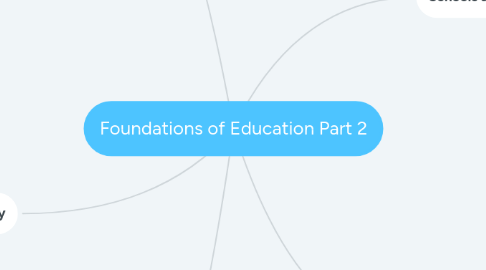
1. Schools as Organizations
1.1. Major Stakeholders
1.1.1. Federal Alabama Senator
1.1.1.1. Richard Shelby
1.1.2. House of Representative
1.1.2.1. Mo Brooks
1.1.3. State Senator
1.1.3.1. Blount County- Shay Shelnutt and Clay Scofield
1.1.4. State Superintendent
1.1.4.1. Michael Sentance
1.1.5. Local Superintendent
1.1.5.1. Rodney Green
1.1.6. Local School Board Members
1.1.6.1. Ken Benton, Chris Latta, Jackie Sivley, Bill Fairy, and Bruce McAfee
1.2. School Processes
1.2.1. The different pedagogic, social, and organizational goals cause their processes to differ.
1.3. School Cultures
1.3.1. Their beliefs, rituals, and political structure impact the schools in different ways.
2. Curriculum and Pedagogy
2.1. Social Meliorist
2.1.1. The school curriculum should teach students to think and help solve societal problems, if not to change society itself.
2.2. 2 Dominant Traditions
2.2.1. Mimetic
2.2.1.1. It is based on the viewpoint that the purpose of education is to transmit specific knowledge to students.
2.2.2. Transformative
2.2.2.1. Proponents of this tradition believe that the purpose of education is to change the student in some meaningful way, including intellectually, creatively, spiritually, and emotionally.
3. Equality of Oppurtunity
3.1. Class impacts educational outcomes by causing parents to expect less from their children, which might cause them to not finish school.
3.2. Race impacts educational outcomes by causing minority students to receive fewer and inferior educational opportunities than white students.
3.3. Gender impacts educational outcomes by causing females to outperform males in most aspects of school except math proficiency and standardized test scores.
3.4. Coleman Study Responses (1982)
3.4.1. In a comparison of test scores from public school and private school sophomores, private school students outperformed the public school students in every subject.
3.4.2. In another argument, Catholic schools advantage low income minority students, and they are also becoming more elite like suburban public schools.
4. Educational Inequality
4.1. Cultural Difference Theories
4.1.1. Working-class and nonwhite students resist the dominant culture of the schools. Students reject the white-middle class culture of academic success and embrace a different culture.
4.1.2. African American students deny their own cultural identities and accept the dominant culture of a white-middle class model in order to succeed.
4.2. School-Centered Explanations
4.2.1. School financing-Since property values are significantly higher in more affluent communities, these communities are able to raise more money for schools than poorer communities with lower property values.
4.2.2. Between School Differences- study shows that working class schools have authoritarian pedagogic practices, middle class schools have more student-centered pedagogic practices, and upper class students will attend elite private schools.
4.2.3. Within School Differences- Students at the secondary level are divided by ability and curriculum. They receive different types of education within the same school.
4.2.4. Gender and Schooling- Schooling often limits the educational opportunities and life chances of women in a number of ways.
5. Educational Reform
5.1. School-Based Reforms
5.1.1. School-Business Partnerships: These were formed to produce the students that are necessary for revitalization of the U.S. economy.
5.1.2. School-to-Work Programs: This system prepares youth for the high-wage, high-skill careers of today's and tomorrow's global economy.
5.2. Reforms that Impact Education
5.2.1. Mayoral control of urban districts eliminates corruption, leads to effective and efficient management and budgets, increases student achievement, and reduces the political battles endemic to elected school boards.
5.2.2. Funding was equalized between urban and suburban school districts to help out children in poorer school districts in 1990.
